8 Wheel of the Year Herbal Activities

by Corinna Wood
Does the Wheel of the Year seem like a mystery to you? Or perhaps the markers just seem to fly by before you even realize that another one has passed? It’s not like your workplace and banks are closed!
Let me share with you 8 seasonal activities for connecting with the plants and the Earth year after year.
While there are many ways to honor the passage of the seasons, in this article I’ll focus on activities grounded in the growth cycles of wild plants and herbs around you.
Nourishing to both body and soul, these will support you staying connected with Mother Earth throughout the year.
Table of Contents
Living the Wheel of the Year
Over decades of living close to nature—in harmony with the rhythm of the seasons—they’ve become integrated into my life and routines.
Making herbal medicines for women’s health and teaching about wild plants meant living the Wheel of the Year, all year, every year.
As much as I fell in love with the green and growing things of the outward seasons, I came to look forward to the winter months when the plants would die back. Ah, such a relief when the plants couldn‘t be harvested or taught about! At last, the year would slow down . . .
As my focus has deepened into realms of the heart, mind and soul, I also see the seasons reflected within me—and within you.
You're welcome to grab a free copy of my quick reference guide on Tuning Into the Wheel of the Year
Honoring the seasonal markers can be as simple as a family ritual of building an outdoor fire at each of the 8 points on the wheel.
 The mere act of pausing, acknowledging and naming the season aloud focuses awareness there.
The mere act of pausing, acknowledging and naming the season aloud focuses awareness there.
And who doesn’t love an outdoor fire!
There are various lenses we can look through to understand the Wheel of the Year and its significance in numerous cultures around the world throughout time.
Through the lens of holistic healing, these seasonal markers also reflect your inner landscape as a woman—and provide opportunities for inner growth and healing.
In this article we’ll focus on 8 fun ways to connect with Mother Earth through her beloved plants.
You can think of these as rituals. As you incorporate these activities into your life year after year, you'll develop a stronger connection with the seasons. And isn’t that what rituals are all about?
1. Imbolc — Keeping the flame burning
 Imbolc is the halfway point between winter solstice and spring equinox. At Imbolc, the wintertime stores of last year’s harvest are naturally running low.
Imbolc is the halfway point between winter solstice and spring equinox. At Imbolc, the wintertime stores of last year’s harvest are naturally running low.
If you shop at the farmers market, you know there’s much less variety at this time–even the supplies of root vegetables are dwindling.
Modern versions of Imbolc include Candlemas and Groundhog’s Day.
When I lived without electricity, I relied on my beeswax candles for light over those long winter nights. By late January, my supply would run low. One of my favorite Imbolc rituals was firing up the wood cookstove to melt more beeswax for making candles.
The groundhog looking for her shadow is rooted in ancient weather divination—how much longer will the winter last? Will it be another 6 weeks, 'til spring equinox?
As food stores dwindle, nibble on early wild edibles
Nibbling on the earliest greens is not only delicious, it’s a natural way to support immunity. Especially when you find wild onion! This humble common plant boasts all the immune and health benefits renowned for garlic and onion.
Keep an eye out for tufts of wild onion in yards or even along the sidewalk. At first you might think it's just grass. You’ll know it’s wild onion by the hollow stalk and pungent onion scent.
If you notice a bit of peppercress or chickweed popping up this Imbolc season, by all means, nibble on those too! It’s always a delight to find those early shoots of the new year’s growth of wild edibles.
And then cozy back up by your warm fire to savor the remaining quiet days and nights of winter.
2. Spring Equinox — Sprouting shoots of youthful growth
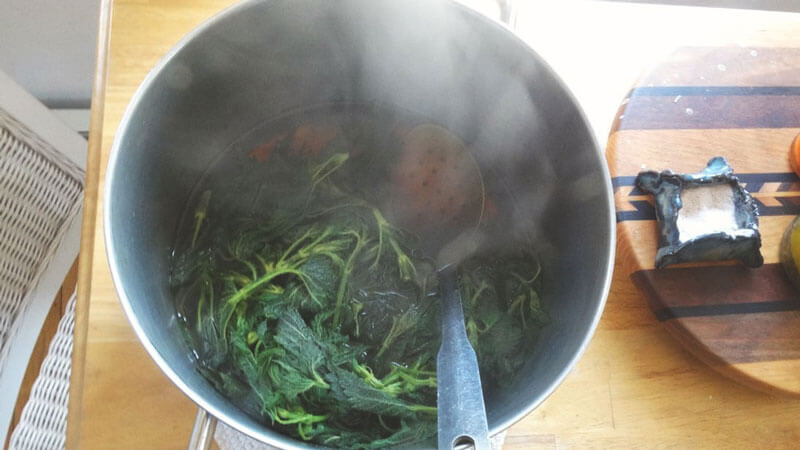 At spring equinox, the days are finally as long as the nights. And the newness of spring is all around, wild herbs sprouting up fresh shoots.
At spring equinox, the days are finally as long as the nights. And the newness of spring is all around, wild herbs sprouting up fresh shoots.
As the Earth begins to come alive again, the growing energy of youth is an opportunity to reconnect with your inner young one. I know my tree-climbing girl gets excited as the wild greens pop up!
A plant walk to harvest spring greens for soup
To connect with the Earth (and your own wild girl within!) this spring equinox, take her outside for a plant walk. See what’s growing around you. Can you two find some nettles? It’s easy, cuz she’ll sting ya!
Don’t worry, the sting dissipates when you cook the greens.
The easiest way to make nettle soup is by simply cooking the greens for 20-30 minutes, scooping them out with the cooking liquid, and adding a little miso or salt.
If you found some other wild edible greens along the way, throw ‘em in too! Or dig some dandelion or yellow dock roots to simmer in your soup for an extra dose of liver support—and Earth-connection.
3. Beltane — Greening of the Earth
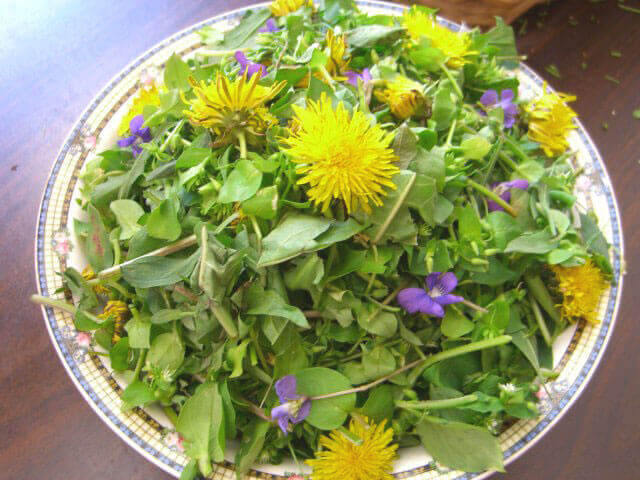 Beltane, known today as May Day, is the halfway point between the spring equinox and the summer solstice.
Beltane, known today as May Day, is the halfway point between the spring equinox and the summer solstice.
The leaves on the trees are unfurling in bright green. And blossoms are beginning to open all around.
Making wild salads and flower crowns
To connect with the Earth in the Beltane season, take your basket out and find one wild green you could snip for your salad bowl. Common edible weeds I harvest at this time include dandelion leaves and flowers, violet leaves and blossoms, and ground ivy.
As you eat wild plants, the lines between food and medicine blur. As you explore this self-reliance, you empower yourself.
Oh, and while you’re connecting with the plants, keep an eye out for cleavers—with her whorl of leaves around the stem and sticky stalks like velcro. Wrap it into a circle to form the basis of a flower crown. Crown yourself queen of your own life!
4. Summer solstice — Growth and creativity abounds
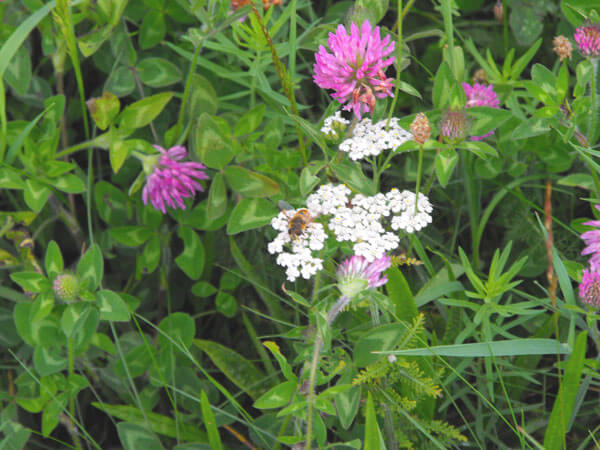 At summer solstice, it seems like everything is ready for harvest all at once! The plants are growing like crazy. Growth, growth all around you.
At summer solstice, it seems like everything is ready for harvest all at once! The plants are growing like crazy. Growth, growth all around you.
In the summer solstice season of your life as a woman, you're a creatrix—creating and tending the gardens of life, the projects (and/or people) to which you gave birth.
Tincturing flowering medicinal herbs
‘Tis the season for the herbs that reach peak medicinal potency in their early to mid flowering stage.
See if you can spot red clover’s pink-purple blossoms along the edges of your paths or garden. (Not magenta—that’s non-medicinal “crimson clover.”)
Or perhaps you have other medicinal flowers growing near you—such as yarrow, elder, or St Joanswort?
Once you positively identify red clover or another flowering plant ally, grab some 100 proof vodka and pack a jar tightly with the plant material of your herb of choice.
Fill your jar again by pouring your alcohol over your medicinal flowers. Let your brew sit for 6 weeks, and then strain out the plant material.
Voila, you have your own potent handcrafted herbal tincture! Yup, it’s that easy. Happy summer solstice!
5. Lammas — Savoring end of summer
 The halfway point between summer solstice and autumn equinox, Lammas is a time of the year’s cycle where you naturally connect with your heart in gratitude.
The halfway point between summer solstice and autumn equinox, Lammas is a time of the year’s cycle where you naturally connect with your heart in gratitude.
Lammas is still sometimes celebrated today with end-of-summer community games on the quad. It's a time of savoring connection, community, and friendship.
Lammas is also an opportunity for savoring and celebrating the garden harvests, as the intensity of the plant growth begins to slow down a bit.
Savor the scents of nature through herbal baths
As you also begin to slow down in the Lammas season, I invite you to explore herbal baths. It can be as simple as grabbing a handful of one of your favorite culinary herbs from your kitchen garden—sage, thyme, oregano, or rosemary.
Or savor the flavor of any and all of the aromatic medicinal mints in your garden–such as lemon balm, anise hyssop, peppermint, or tulsi. I enjoy them in summer coolers to beat the heat during the day, and in soothing baths at night.
If you happen to have the “invasive weed” known as mugwort, just inhaling the scent connects you between the worlds. Known for her uses in dream pillows and smudge sticks, mugwort is another alternative to throw in your herbal bath. Mugwort's peak potency is in her flowering stage, which falls right around Lammas.
6. Autumn equinox — Celebrating fruition
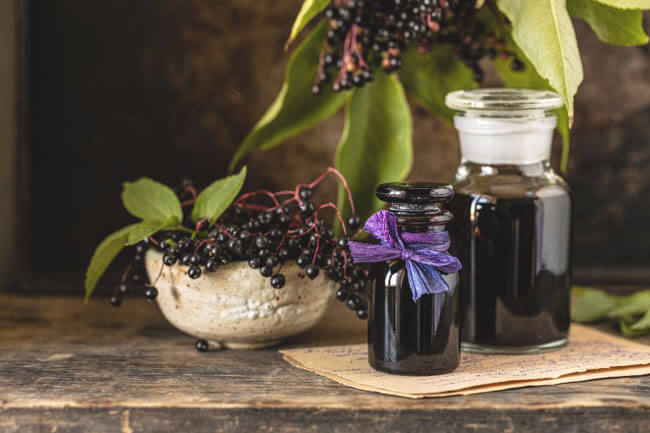 At autumn equinox, many plants come to fruition as their blossoms ripen into fruits and berries.
At autumn equinox, many plants come to fruition as their blossoms ripen into fruits and berries.
Autumn equinox harvest festivals today still include hayrides and apple cider.
As the night once more becomes as long as the day, you become aware of your limits. Each day between now and winter solstice gets shorter—and there’s only so many days between now and the impending winter.
Harvesting medicinal berries
In the herbal world, various medicinal berries come to fruition around fall equinox.
Elderberries are a favorite to harvest for wintertime immune support. Have you seen a spot near you with those flat-topped clusters of deep-red little berries? Bring a jar with you next time, to fill with those juicy berries. When you get home, fill your jar again with 100 proof vodka.
Or maybe you’ve noticed red hawthorn berries among the craggy thorns. Vitex berries also are ripening at this time, dark brown in long bending cones among the palmate leaves.
Choose one. Any of these medicinal berries will extract well into alcohol. Allow your medicine to brew for 6 weeks—at Samhain, it will be ready for you to strain out the plant material and take a daily dose as the seasons turn.
7. Samhain — Down to the roots, between the worlds
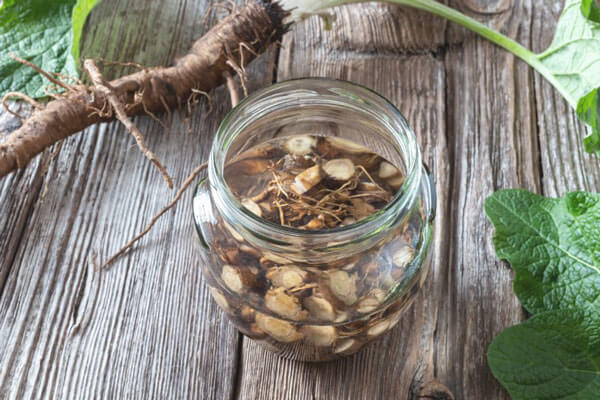 This halfway point between autumn equinox and winter solstice is celebrated today as Halloween, formerly known as Samhain.
This halfway point between autumn equinox and winter solstice is celebrated today as Halloween, formerly known as Samhain.
The “spooky” flavor of the holiday reflects vestiges of the inherent seasonal changes as late autumn shifts into early winter.
In traditional cultures, the veil between the worlds is considered to be thin at this time of year. The spirit worlds—and your beloved dead—may be easier to access at this time. Latin and Caribbean cultures still celebrate the Day of the Dead on November 1.
Samhain season brings you back down to your roots. As the leaves fall and the plants die back, you can see the “bones” of the trees. After the initial hard frosts, perennial herbs send their energy down below the ground to their roots.
Digging medicinal roots of wild weeds
To connect with the Earth in the Samhain season, get out your wool socks and your shovel. Dig your hands down into the dirt to harvest some of the medicinal roots.
Do you have any of these three common abundant medicinal “weeds” nearby: burdock, yellow dock or dandelion? Their healing roots support your kidneys, liver, hormonal system, and internal organs through the winter time. Or perhaps you have comfrey or poke?
Keep it simple. Choose one that’s nearby to ally with. You can always do more next year.
Any and all of these medicinal roots reach peak potency as the frosty weather blows in. Working with herbal roots will remind you to return to your own deep roots.
8. Winter solstice — The long nights pull you inwards
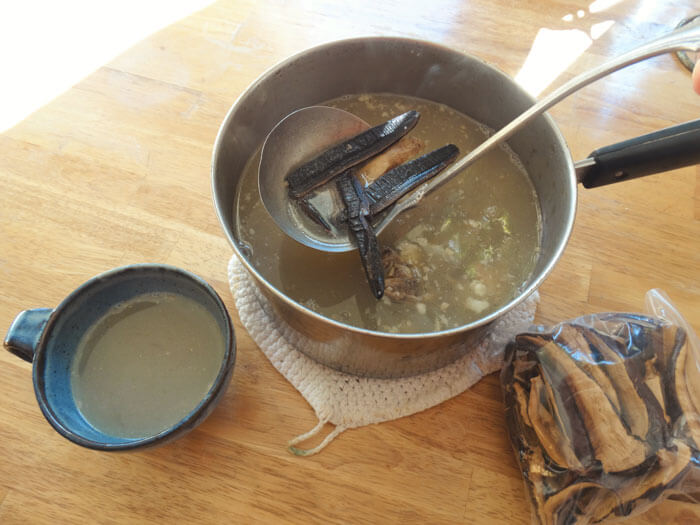 As you may know, the roots of Christmas are in ancient winter solstice celebrations.
As you may know, the roots of Christmas are in ancient winter solstice celebrations.
The yule tree was adorned with decorations, beside the yule log crackling in the fireplace.
In ancient European traditions, “Mother Christmas” was revered long before today’s Santa Claus. Goddesses such as Saule and Beiwe, were known for flying across the sky with their reindeer (and didja know it’s the female reindeer that keep their antlers over the winter?).
Yet as much as today's version of the holidays pull you outward, your internal voices pull you inward. On the the longest nights of the year, the dreamtime calls.
The plants are resting. How do you allow yourself to rest?
Sipping hot broth simmering on the stove
This winter solstice season, I invite you to cozy up in your favorite quiet spot with a mug of herbal broth.
I love to brew bone broth (veggie broth works too, or just plain water) with any combination of these potent immune-supportive wintertime herbs:
- Reishi or chaga mushrooms
- Astragalus or elecampane roots
- Onions or seaweed
They’re all available as dried herbs in natural food stores. Which one is easiest for you to incorporate into your kitchen this winter solstice?
Choose one or more of these potent nourishing herbs to simmer on the stove in a pot of water or broth, for at least a few hours. Ladle yourself a hot steaming cup to curl up with—and allow yourself to rest.
Wheel of the Year 2025
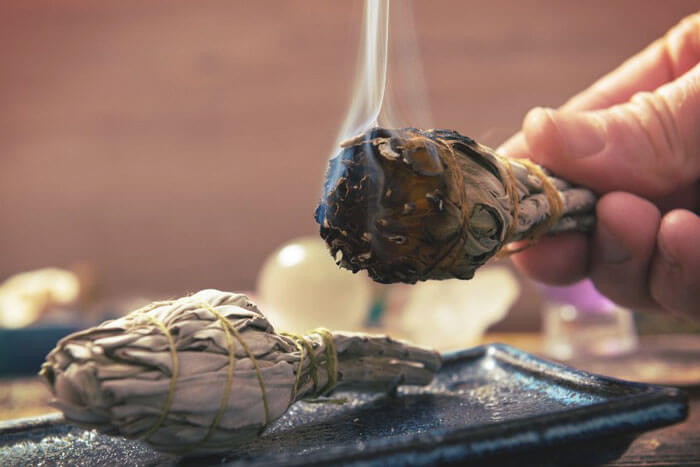 Remember, if you miss the precise day of the solstice, equinox or other holy day . . . no worries.
Remember, if you miss the precise day of the solstice, equinox or other holy day . . . no worries.
These 8 turnings around the wheel of the year aren’t just one day. They’re a whole season. And you might find yourself repeating the ritual at various points of the season anyway!
Nonetheless, here’s a quick reference for you of the official dates for the Wheel of the Year 2025:
- Winter solstice - Dec 21, 2024
- Imbolc - Feb 1, 2025
- Spring equinox - March 20, 2025
- Beltane - May 1, 2025
- Summer solstice - June 20, 2025
- Lammas - August 1, 2025
- Fall equinox - Sept 22, 2025
- Samhain - October 31, 2025
- Winter solstice - December 21, 2025
Following the rhythms of nature through the Wheel of the Year
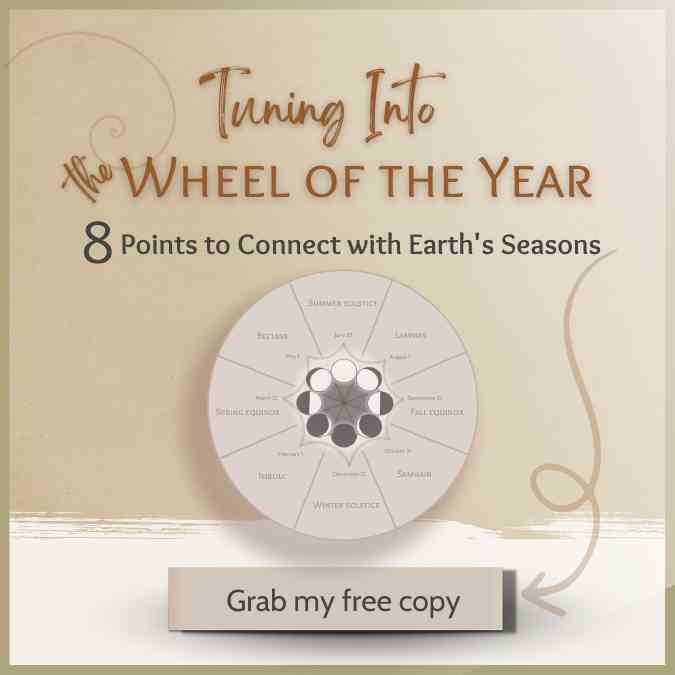 If you’re wondering how you’ll find some (or any!) of the plants I’ve mentioned here . . .
If you’re wondering how you’ll find some (or any!) of the plants I’ve mentioned here . . .
Let’s take a deep breath. Remember, it’s not just one day–it’s a whole season.
Start with one or two points on the year—perhaps one coming up, or another that inspires you. You could also just start one one that has a plant you're already familiar with!
Consider it part of your ritual, over the course of those 6 weeks, to see if you can find one of the plants I mentioned growing near you. If not fresh and wild, dried in the store.
You'll be healthier and happier for it. Something about connecting with the Earth through the plants lights you up. This is the seasonal ancient ways of your foremothers. For many women, connecting with the plants feels like remembering what you already knew.
The Wheel of the Year reflects your internal landscape
As you begin to adopt some of these practices—and/or develop your own—you’ll become more and more in tune with the seasons.
You’ll find yourself curious, perhaps opening up to what else the season has to offer you. How else could the season support your inner landscape?
For example, watching the leaves fall gives you permission to connect with mourning your losses.
Watching the plants send their energy down to the roots gives you permission to rest along the spiral of your days and years.
As you internalize these rhythms of nature, you’ll see this is not just a formal ritual on a specific day.
This is a way of life.
A way of living in harmony with the seasons. A way of staying connected with the Earth throughout the year. A way of nourishing yourself, body and soul.
____________
Spread the wise woman ways! Link to this article from your website or share with your friends using this button~
Comments ~ what stands out for you today?








